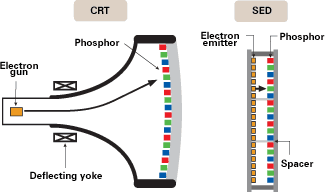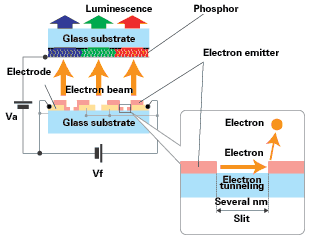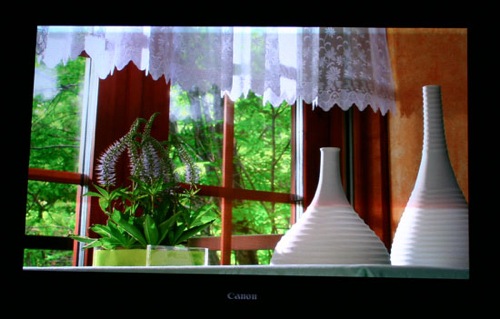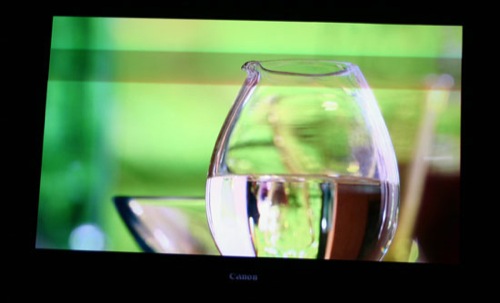CES 2006 - Day 3: Playstation 3, Quarter-size Hard Drives, SED and lots of TVs
by Anand Lal Shimpi & Manveer Wasson on January 9, 2006 1:25 AM EST- Posted in
- Trade Shows
Canon and Toshiba Demonstrate SED TVs
Canon and Toshiba have been working on yet another display technology called SED (Surface-conduction Electron-emitter Display). The goal of SED is to bring some of the good qualities of CRT displays (response time, brightness, black levels) to a fixed pixel, very thin, low power display.
The technology works very similarly to older CRT displays, except on a much smaller scale. In a CRT display a Cathode Ray Tube (CRT) would shoot electrons at phosphors behind the viewing glass to effectively paint the picture you see on your monitor. In a SED display, individual electron emitters shoot electrons on phosphors behind the viewing screen to create the pixels on your screen.

CRT vs. SED - provided by Canon Technology

How SED Works - provided by Canon Technology
Since a large CRT isn't necessary, SED TVs can be several centimeters thick rather than tens of inches. But with the response time, brightness, color reproduction and black levels comparable to CRT displays, SED technology has the potential to be the best of both worlds.
Like LCD and DLP technologies, SED displays are fixed pixel displays and there are three electron emitters per pixel. The downside to a fixed pixel display of course is that you end up sacrificing quality if you display content isn't at the same resolution as the native resolution of your display. In other words, there should be a 1:1 mapping of content pixels to each group of RGB electron emitters to obtain the absolute best image quality. However, as hardware scalers become more and more powerful the 1:1 pixel mapping problem becomes less important.
About six years ago Canon and Toshiba started working on developing SED technology for consumer TVs, and they are supposed to start shipping the first SED panels later this year. At the show both companies had demos of SED TVs (they looked to be around 30" diagonally). The conditions weren't perfect to truly evaluate the technology since they were in extremely dark rooms and with no other displays available for direct comparison. That being said, the image produced looked very nice. With no other types of TVs in the room we can't really say how it compared to LCD or Plasma TVs (SED's closest competitors), but it did look very good.

One thing we did notice was that the displays looked like they had extremely low refresh rates. You could see the screen refreshing much like a CRT set to 60Hz. Granted the technology is still pre-production so that could explain the issue.

The dark bar across the screen is our camera capturing the visible refresh rate on the display










45 Comments
View All Comments
andrewln - Monday, January 9, 2006 - link
some very interesting products..SED, 82" LCD?!.. 103" plasma..tiny projector....4K projector
clear raptor...finally, something new for hard drives
dual lense camara
dissapointments? or i'm wrong?
0.85" 4GB hard drive?...can't they make 4GB sd already, not moving parts and requires less power
nano clones..? why not make it better rather just cloning?
wireless tablet....i thought we have those already
ps3....no coment
MrSmurf - Monday, January 9, 2006 - link
Things like the small HDD are more to impress us with how far technology has advanced. It's a novelity.swtethan - Monday, January 9, 2006 - link
by samsung... worlds largest... hehehelittlebitstrouds - Monday, January 9, 2006 - link
I want a 103" plasmaswtethan - Monday, January 9, 2006 - link
sweet stuff!